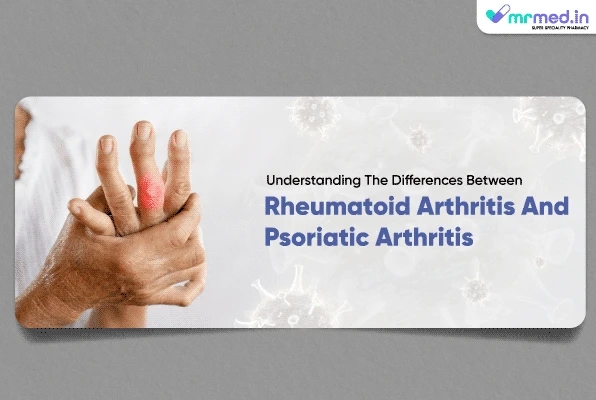Introduction
Arthritis is a condition that results in inflammation of joints. Psoriatic Arthritis and rheumatoid Arthritis are two different types and also misunderstood diseases. It is important to understand the distinctions and similarities between these illnesses to manage them in a successful way.
What Is Rheumatoid Arthritis?
It is an autoimmune disorder in which our own immune system attacks healthy joint tissues, causing joint inflammation and damage.
Prevalence And Demographics
According to the World Health Organisation, 18 million people are affected globally by rheumatoid Arthritis. The prevalence of rheumatoid Arthritis is three times increased in women compared to men. In women, it most commonly begins between ages 30 and 60.
Common Symptoms Of Rheumatoid Arthritis
- Joint pain.
- Joint stiffness
- Tenderness and swelling joints.
- Weight loss.
- Fever.
- Fatigue or tiredness.
- Weakness.
Diagnostic Methods
Rheumatoid Arthritis is diagnosed through clinical evaluation, imaging tests (like X-rays and MRI), and blood tests that measure specific antibodies and inflammation markers.
What Is Psoriatic Arthritis?
Psoriatic Arthritis is a unique form of Arthritis closely associated with psoriasis, a skin condition.
Relationship to Psoriasis
Around 30% of people with psoriasis develop PsA. Both conditions share common genetic and immune system factors.
Prevalence and Demographics
Psoriatic Arthritis affects between 10-30% of individuals with psoriasis. It usually appears between the ages of 30 and 50, but it can develop at any age.
Common Symptoms of Psoriasis Arthritis
- Joint pain
- Stiffness
- Swelling
Diagnostic Methods
It involves evaluating the patient\'s medical history, physical examination, imaging studies, and blood tests, similar to RA.
Differences Between Rheumatoid Arthritis and Psoriasis arthritis
1. Onset and Age of Onset
Rheumatoid Arthritis often begins gradually and can strike at any age, while psoriatic Arthritis is more common in those with existing psoriasis, typically appearing between the ages of 30 and 50.
2. Symptomatology Differences
Rheumatoid Arthritis mainly affects small joints and is characterized by symmetrical joint involvement, whereas psoriasis arthritis may cause asymmetric joint and spine.
3. Joint Involvement Patterns
Rheumatoid Arthritis mainly targets synovial joints. In contrast, psoriatic Arthritis can involve not only synovial joints but also the entheses (the areas where tendons and ligaments attach to the bones).
4. Association with Other Conditions
Psoriatic Arthritis is closely associated with psoriasis, while rheumatoid Arthritis isn\'t directly linked to any specific skin condition.
5. Genetic Factors
Both conditions have genetic components, but different genes are associated with each, contributing to the distinctions in their pathophysiology.
Similarities Between Rheumatoid Arthritis and PsA
Despite their differences, Rheumatoid Arthritis and psoriatic Arthritis share several commonalities:
- Inflammatory Nature: Both conditions are inflammatory autoimmune diseases, leading to joint inflammation and pain.
- Impact on Daily Life and Quality of Life: Rheumatoid arthritis and psoriatic Arthritis can significantly impact a person\'s daily activities and quality of life due to joint pain and fatigue.
- Risk Factors: Family history and genetic factors are common risk factors for both conditions.
- Diagnosis and Differential Diagnosis: Distinguishing between Rheumatoid Arthritis and psoriatic Arthritis can be challenging due to their overlapping symptoms. Imaging, such as X-rays, MRIs, and blood tests measuring specific antibodies and inflammation markers, is vital in arriving at an accurate diagnosis. Early diagnosis is critical for effective management.
Treatment Approaches
Both Rheumatoid Arthritis and psoriatic Arthritis require personalized treatment plans. Common treatment options include:
1. Nonsteroidal anti-inflammatory drugs (NSAIDs)
NSAIDs like ibuprofen and naproxen are commonly used to relieve pain and reduce inflammation in both rheumatoid Arthritis and psoriatic Arthritis. They provide symptomatic relief by targeting the inflammatory process, but they do not modify the underlying disease progression.
2. Disease-modifying antirheumatic drugs (DMARDs)
DMARDs such as Tofajak 5mg Tablet, which contains tofacitinib, manage both conditions. They not only alleviate symptoms but also slow down the progression of rheumatoid Arthritis and psoriatic Arthritis by suppressing the autoimmune response and reducing joint damage.
3. Steroids
Steroids like prednisone may be prescribed for short-term relief of acute symptoms in RA and PsA. They are potent anti-inflammatory medications but are typically used sparingly due to potential side effects when used long-term, such as bone density loss and immune suppression.
Biologic and Targeted Therapies for Both Conditions
Rheumatoid and psoriasis Arthritis can be treated using the following inhibitor (involved in inflammatory reaction), which are given below:
- TNF inhibitors
- IL-17 inhibitors
- IL-23 inhibitors.
Lifestyle And Complementary Treatments
- Physical therapy
- Exercise
- Dietary modifications.
Strategies To Deal With RA And PsA
There are strategies for managing both the arthritis conditions and improving overall well-being:
- Using devices that can assist you in managing arthritis pain(openers, food processors, mandolins for slicing make work easier). You can also ask for emotional support
- You can do simple movements such as slowly raising and lowering your legs while seated comfortably
- Consult your doctor to get relevant advice for health.
Conclusion
This article helps everyone to understand the differences between rheumatoid Arthritis and psoriatic Arthritis, which is essential for early diagnosis and effective management. While these conditions have similarities, their distinct characteristics and treatment approaches highlight the need for tailored care. By staying informed and raising awareness, we can empower those affected by rheumatoid Arthritis and psoriatic Arthritis to lead healthier, more fulfilling lives.



